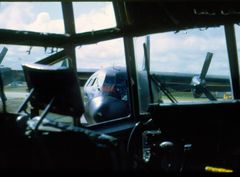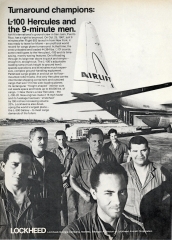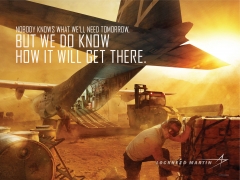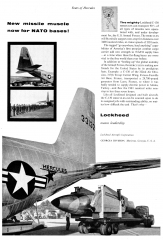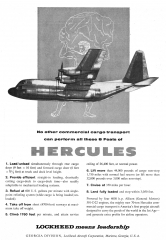-
Posts
367 -
Joined
-
Last visited
-
Days Won
4
Content Type
Profiles
Forums
Store
Gallery
Downloads
Calendar
C-130 Hercules News
Everything posted by Robert Podboy
-
What early C-130 systems had vacuum tubes?
-
Connect the dots
-
“Some predict that the C-130 will continue to operate well into the 21st century…”
-
Naha FB group, I just found this a couple of weeks ago. For those of us who were stationed at Naha AB you may want to check this out and consider joining the group. https://www.facebook.com/groups/73013675579 Bob Podboy 374th Jet MX
-
Dennis, I was at Naha with the 374th FMS 69 / 70, 43250, worked C130A's across the runway, easy area, engine conditioning. TDY’s to Vietnam always had orders cut showing who was coming and who was going. (See example) If you remember someone you went with maybe you can look them up and ask if they have a copy of the orders. With the copy of orders… VA accepted boots on the ground and my DD-214 was updated to show Vietnam Service medal.
-
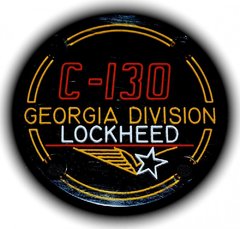
JohnAllen-Jun_69.jpg.76769283180d4e7eec0d13ef11c3f92c.jpg
Robert Podboy commented on casey's gallery image in Member Albums
-
Sam, I should have said … I was assigned to the 374th FMS and was not directly assigned to the 374th TAW. The 374th FMS did not share in the AFOUA award with the 374thTAW while I was assigned to the unit. Bob
-
Not sure about TAW, but for FMS at Naha: The 374th FMS received the PUC for the inclusive period of 8 Aug 1967 to 7 Aug 1968. The 374th FMS was not directly assigned to the 374th TAW and did not share the AFOUA. Hopefully, by now, there is a new batch of ‘attendants’ at New Cindy. Bob
-
Naminoue top 100
-
But Captain Higgens is looking great…
-
a film by Alan Stinar https://youtu.be/XSLdee58tLA
-
Kit Up.... post-production enhancement C-130 MICROVANES® Lockheed Martin has conducted extensive studies to reduce C-130 fuel consumption. Microvanes have proven to be the most cost effective improvement, as they are low cost to manufacture and procure, easy to install and provide significant fuel savings of more than 3 percent on average. The C-130’s at cargo ramp and door give it an exceptional airdrop capability. However, this same feature creates a significant amount of drag due to the abrupt change in air flow from the sides to the ramp/ door. Drag and fuel usage are directly related. Lockheed Martin teams performed fluid dynamics studies and identified Microvanes as the best solution to minimize drag on the C-130 aircraft . Microvanes are small devices, approximately a foot long and an inch and a half tall. They are installed in sets of 20 on the body of the C-130, with 10 vanes per side and reduce drag by modifying the air flow and thereby increasing fuel savings. Flight testing has been conducted to verify Microvanes reduce fuel burn as predicted in operational scenarios and have no adverse impact on airdrop operations from the ramp or paratroop door. Microvane Kit: Microvanes installed on can be completed in one day with an attachment adhesive and a specialized tool for location. The installation tool can be re-used for subsequent installations. Microvanes can be added and removed without permanent alteration to both legacy and J model aircraft.
-
My VFW posts web site www.vfw9678.org now has link to c-130hercules.net How cool is that? LOL
-

C-130 News: Flying with the 'Blue Collar Guys' on a C-130 Mission in Iraq
Robert Podboy replied to casey's topic in 2017
The reporter is Oriana Pawlyk Military.com | 29 Jun 2017 | Picture slide show @ http://www.military.com/daily-news/2017/06/29/flying-blue-collar-guys-c130-mission-iraq.html -
C-130 pilot takes aircrews down memory lane By Staff Sgt. Guy Volb 374th Airlift Wing Public Affairs Like a time capsule retrieved after 30 years, Lt. Col. (retired) Phillip Collins resurfaced in his old stomping grounds here this month to share experiences gained from his many years in the cockpit during the infancy of airlift. There was a time in the late 50s and early 60s, he offered, when being stationed in Japan meant 25-cent haircuts and an enticing yen rate of 375 to the dollar. During his vacation here the lanky, spry, 63-year-old Collins spoke to Yokota's airlift crews about his and the C-130's historical airlift past — complete with the many flight innovations he helped make. Ironically, while many of today's crews weren't even born when he was flying, the mode of transportation remains the same — the C-130 Hercules. Collins' journey down memory lane began in August 1956. As a new graduate of the San Angelo, Texas, flight school, where he flew B-25s, he was assigned to Ashiya, Japan, where he flew the C-130's predecessor, the C-119. As a member of the 37th Troop Carrier Squadron, a relative of Yokota's 36th Airlift Squadron, the 37th TCS performed "airlift missions" much like the 36th and 30th Airlift Squadrons do here now. Following his sixth-month stint at Ashiya, Collins made his first swing through the local area. He was assigned to what is now Showa Kinen Koen (Park) in Tachikawa, then home to the 21st TCS. Once again he flew airlift missions on C- 119s. But it was in 1959, after the 21st TCS had moved to Naha, Okinawa, when his career made a bee-line for the history books. With C-130s operational throughout the world, Collins left the Far East for Sewart Air Force Base, Tenn., eventually flying with the short-lived Hercules aerial demonstration team known as the Four Horsemen. He said the C-130 was unique at that time since it handled much like a fighter. The Air Force shut us (the four horsemen) down before we became too active,”he said with a chuckle. "But for the year I was at Sewart we were in great demand. "An interesting aside," he said, "was that we would go out to the flightline and just pick four aircraft. We used any four the maintenance folks declared operational. There was no special selection process." Collins said they put on a typical airshow. "We flew close formations, which no longer happens," he said using his hands to describe other maneuvers they used. "We'd fly a diamond formation, arrowhead and we would normally finish the show with a low-level, 300 knot 'bomb burst.' For a big aircraft to perform this back in those days was unusual since there wasn't another four-engine aircraft of that size that could maneuver like that." A year later Collins moved to Dyess Air Force Base, Texas, where he spent four years involved with C-130 ski operations. He would use large ski pads to land on ice and snow in Greenland, more than likely an initiative taken as a result of the cold war. Then in 1964, during his next assignment at Eglin AFB, Fla., events thrust him into modern airiift history books. As a member of the 4485th Test Wing, he was one of a few crew members involved with eveloping C-130 tactics, delivery systems and instrumentation still used today. It was Collins, and members of eight other crews who completed the first-ever assault landing on a 2,000-foot runway. The landing technique which helped them stop in an average of 1,200 feet, is still used today and was important then since ground troops in Vietnam needed close are support. “Vietnam was beginning to heat up,” he said, “and the Army wasn’t sure the Air Force could provide the technical airlift they needed. They wanted the funding to build their own flying units. But the Tactical Air Command said it could do it and we were going to prove it.” He said the short-runway assault landings were the result of this disagreement between the Army and Air Force. “At that time,” he said, “there had never been a C-130 to land on a runway 2,000-feet or smaller. Yet the Air Force said it could be done — it was a matter of record. So the Army, thinking it had the Air Force’s number, basically said put up or shut up.” The Army built a 2,000-foot dirt runway with 50-foot obstacles on either end of the runway on the range at Eglin. “They said ‘the Air Force’s tactical documents said you can do it. We built the runway, show us.’ “Needless to say we’re all looking at each other thinking ‘you’ve got to be kidding, you want us to land on that small runway?’ But the Air Force said you got to do it, since they said it could be done.” Collins said Lockheed pilots were even sent to Eglin to show them techniques they felt could be used for short-field landings. “But after seeing them land several times,” he said, “we felt we needed to come up with our own techniques. They were driving the plane into the ground and the wing tips were flapping all over the place. We told the wing commander to send the Lockheed pilots home.” And he did. So Collins and the other crews developed the assault landing technique, and many of the exotic delivery systems used to this day such as the Low-Altitude Parachute Extraction System or LAPES. Then in 1966 he returned to the Far East for a final tour of Japan, to the 6091st Reconnaissance Squadron here, bringing his career full circle. It took Collins 30 years following that tour to return to Japan, but in doing so he gave today’s airlift pilots insight to some early C-130 history.
-
For C-130H-30 Super Hercules front plug 2.54 m rear plug 2.03 m… but C-130Q may be different
-
Lockheed said: Airlift International’s ground crew in San Juan, Puerto Rico, has a right to be proud. On Oct 25, 1967, just 9 minutes after Flight 603 taxied in from New York, it was ready to leave for Miami – an unofficial world record for cargo plane turnaround. In, that time, the crew unloaded and loaded 44,364 lbs. Ok… is this THE world record. Or have you done better?… and want some recognition.
-
Turnaround champions: L-100 Hercules and the 9-minute men. Airlift International’s ground crew in San Juan, Puerto Rico, has a right to be proud. On Oct 25, 1967, just 9 minutes after Flight 603 taxied in from New York, it was ready to leave for Miami – an unofficial world record for cargo plane turnaround. In, that time, the crew unloaded and loaded 44,364 lbs. Of course, some credit goes to Hercules L-100 and its timesaving, money-saving features. On / off loading through its large rear doors is quick and simple – straight in, straight out. The L-100’s adjustable loading ramp (truck height to ground level) speeds operations and eliminates much expensive, complex ground-handling equipment. Palletized cargo glides in and out on its floor-mounted rolled tracks. And only Hercules carries intermodal shipping containers and outsized cargo that won’t fit into side-loading planes. Its rectangular “freight-shaped” interior cuts out waste space and holds up to 48,000 lbs. of cargo. Now there’s a new Hercules - the l-100-20. New engines make it 16 mph faster and its fuselage has been “stretched” by 100 niches increasing volume 20%. Lockheed is also developing the world’s largest plane – the L-500 Galaxy – to meet cargo demands of the future. LOCKHEED Lockheed-Georgia Company, Marietta, Georgia/ A Division of Lockheed Aircraft Corporation
-
-
Back in the day, (circa 1957) Lockheed ads said early A models could be “ Loaded / unloaded simultaneously through rear cargo door (9 feet x 10 feet) and forward cargo door (6 feet x 6 ½ feet) at truck and dock level height.” Does anyone remember this actually happening... if so give an example… or was this Lockheed marketing bull.
-
Feats of Hercules New missile muscle now for NATO bases! The mighty Lockheed C-130 HERCULES can transport 90% of all types of missiles now operational with, and under development for the U. S. Armed Forces. The HERCULES will fly missile cargoes non-stop for distances over 3400 nautical miles, at cruse speed of 305 knots. The rugged “go anywhere, haul anything” capabilities of America’s first prop-jet combat cargo carrier add new strength to NATO supply lines – at a time when these far-flung bases are more vital to the free world than ever before. In addition to “beefing up” the global mobility of the Armed Forces, the HERCULES is making new friends for the United States by its prodigious feats. Example: a C-130 of the 322nd Air Division, 317th Troop Carrier Wing, Evreux-Fauville Air Base, France, transported a 28,700 pound generator from Laon, France, to where it was badly needed to supply electric power in Adana, Turkey – and flew the 1981 nautical miles non-stop in less than seven hours. Like all Lockheed designed and built aircraft, the C-130 HERCULES can be counted upon to do its assigned jobs with outstanding ability, no matter how difficult the task That’s why – LOCKHEED means leadership Lockheed Aircraft Corporation GEORGIA DIVISION, Marietta, Georgia, U. S. A. Reference publication: Flight April 25th 1958 Thanks to Dave Robinson for this Hi Res ad http://www.aviationancestry.co.uk/?advert/&advertId=38921
-
No other commercial cargo transport Can perform all these 8 Feats of HERCULES 1. Load / unload simultaneously through rear cargo door (9 feet x 10 feet) and forward cargo door (6 feet x 6 ½ feet) at truck and dock level height. 2. Provide efficient straight-in loading, drastically cutting cargo-dock to cargo-dock time – also readily adaptable to mechanical loading systems. 3. Refuel at 600 U.S. gallons per minute with single-point refueling system (while cargo is being loaded / unloaded). 4. Take off from short (4700-foot) runways at maximum take off weight. 5. Climb 1760 feet per minute, and attain service ceiling of 26,400 feet, at normal power. 6. Lift more than 44,000 pounds of cargo non-stop 1,750 miles with normal fuel reserve (or lift more than 32,000 pounds over 3,000 miles non-stop). 7. Cruise at 350 miles per hour. 8. Land fully loaded and stop within 3,050 feet. Powered by four 4050 h. p. Allison (General Motors) 501-D22 engines, the mighty new 70-ton Hercules commercial cargo transport is America’s first propjet aircraft designed to carry the goods of the world in the Jet Age – and generate extra profits for airline operators. LOCKHEED means leadership GEROGIA DIVISION, Lockheed Aircraft Corporation, Marietta, Georgia, U. S. A. Reference publication: Flight November 15th 1957 Thanks to Dave Robinson for this Hi Res ad http://www.aviationancestry.co.uk/?advert/&advertId=38547
-
See p.22 thru 27 Nov-Dec-12Lowres.pdf




